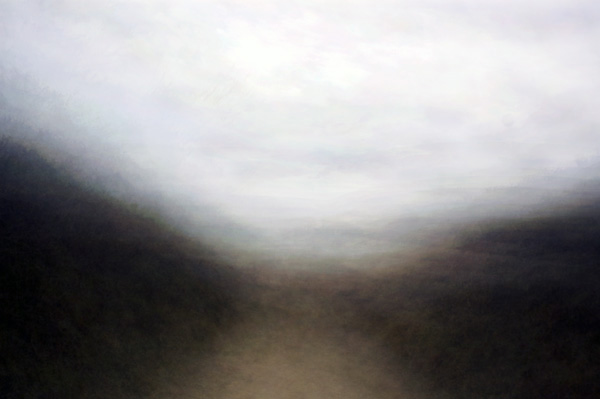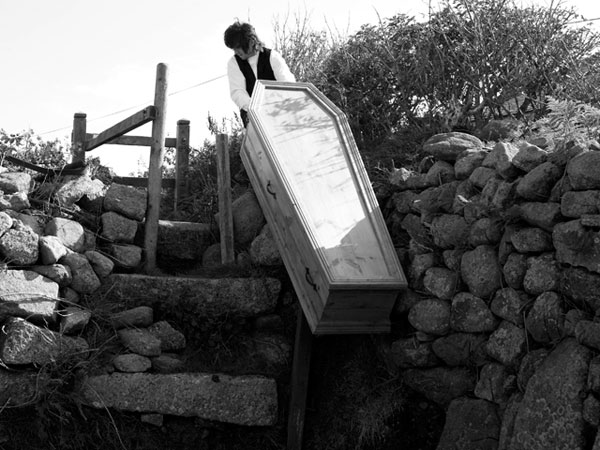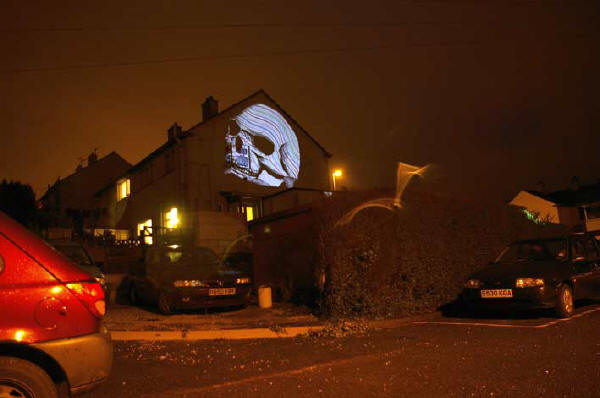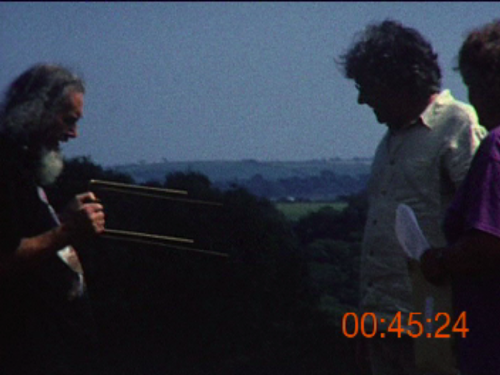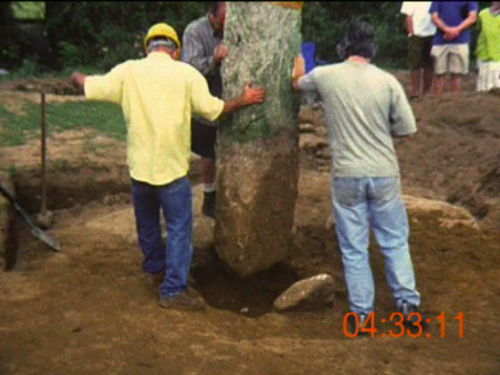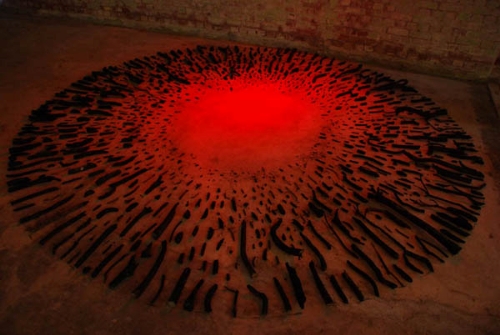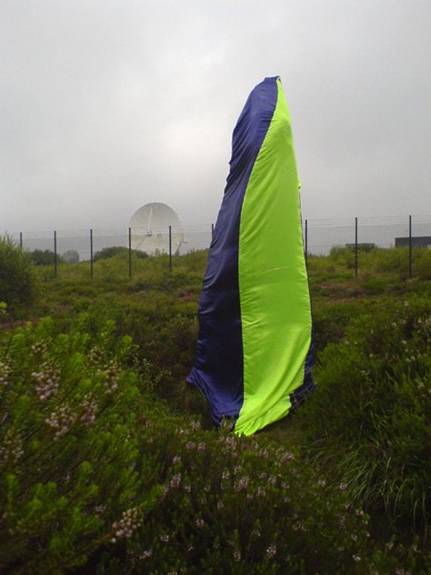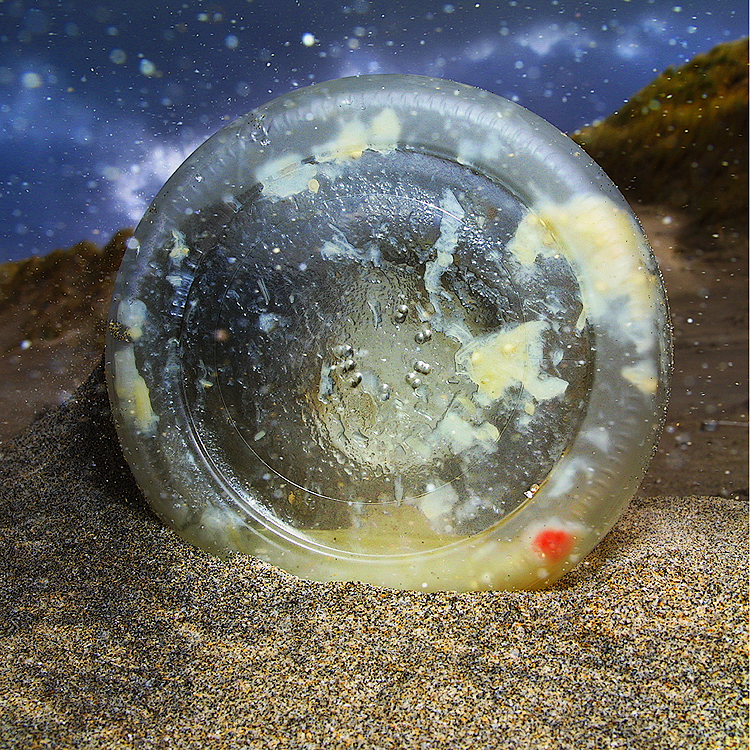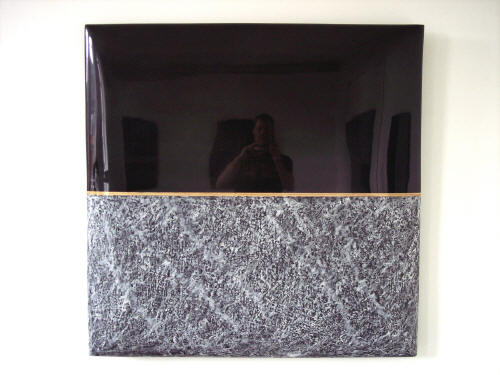|
|
| home | features | exhibitions | interviews | profiles | webprojects | gazetteer | links | archive | forum |
|
'The New Landscape': from a point of view on the work to a being in it?[1] Harriet Hawkins
Harriet Hawkins is a research fellow in Geography at Exeter University h.hawkins@exeter.ac.uk
The complex relationship between an artist and their subject is central to our understanding of landscape art. This article explores the contemporary articulation of this relationship within the work of the eleven artists included in the exhibition The New Landscape (showing at Royal Museum Cornwall at Truro until March 19th). It discusses the works through the relating of two possible functions of ‘new’ in the exhibition title: the renewal of human-environment relations as a key coordinate for current Cornish landscape practice, and the potential of new media art (video, installation and performance works for example) to orchestrate artist (and audience) environmental engagements. Within the embrace of such comparatively ‘new’ art practices, comes the potential to orchestrate a critical relationship not only between artist and landscape but also between audiences and landscapes. The commentary on the work will be set within the theoretical framework of a ‘new’ understanding of landscape that has emerged in cultural geography in recent years. Attention will focus on three themes. First, and running throughout the article, will be the importance of being in the landscape for both artist and audience. This is found principally in The New Landscape works in a sense of a moving through and engaging with landscape rather than looking on it. Secondly, attention will be paid to the temporality of landscape, and thirdly, the problematic binary of nature/culture will be explored.
As a collection, the series of the works move us through landscapes which were resolutely deep and living. Ian Brown’s photomontages (Hogweed (Cornwall), 2006; Loe Bar (Cornwall), 2007 (above)) initially appear to employ the traditional framing and compositional devices of landscape work. However on closer examination Brown is seen to transform a ‘static’ viewpoint into a fluid movement through landscape. The layers of images are built from multiple exposures into haunting compositions, capturing and communicating the artist’s incorporation with his landscape subject: a moving through rather than a gazing on. Indeed, far from a static and fixed entity, landscape, as anthropologist Tim Ingold demonstrates, is an accomplishment of time. It tells, or rather is, a story enfolding the lives and times of those who have dwelt/dwell in it. Ian Whitford’s piece Captain’s Triptych (2008) (picture below - see also 'webprojects') consists of three videos made as he drags a coffin from Captain’s Cottage in Zennor to the coffin rest outside Zennor church. The first two sequences follow the protracted bodily labouring of the artist. The video shifts from black and white to colour, tracking artist’s and coffin’s passage from the cottage, around farmland, across open heath to the road. The videos are accompanied first by the muted scuffing of the coffin through vegetation and later the rasp of wood against the road. In the final sequence a women stands outside the now empty cottage, rapping repeatedly on the wooden door.
The extended passage through the landscape is bound together with the passing of time and rhythms of life. These are lives both of community and of individual; from the end of one life (presumed by the coffin), to the demise of community, figured by the empty house (now a holiday cottage). Landscape here, as with other works in the exhibition, is not a mute backdrop across which events are played out. Instead landscape is bound into the narrative. Landscape is interactivity, a living process, ‘it makes men and is made by them’ (Inglis 1977:489). One of the striking features of the exhibition are the multiple modes of knowing landscape that viewers are offered. These are modes of knowing which move beyond the register of seeing. The artist’s works develop instead a landscape experience akin to what Ingold has described an ‘educative attention’ to landscape. But it is not only the artist who participates in such an engagement but the audience too. One re-occurring presence within the exhibition was a sense of a deeply historicised Cornwall. However, these ‘picturings’ of the past did not strike an overly melancholic register. Instead of looking back, mourning lost productivity, these historicised landscapes play forward into the social and economic issues that the region faces today. As a result the continued historical presence creates for the landscape a very particular temporality.
Archaeology, its practices, knowledges and artefacts, are an increasingly common theme in contemporary artwork. The ‘New Landscape’ artists enrol a series of local archaeologies, which taken as a group form an intriguing set of multi-layered archaeologies. They move us from the conventional ‘deep’ archaeological time to the highly contemporary archaeologies/anthropologies of Daryl Waller’s careful observed social commentary. From the well sited, if sinister ‘Happy?’ (2007) (above) to the social commentary of his drawing, 'Coca-cola tap', (2005) Waller offers us a highly situated critique of contemporary living. These are critiques which he threads through daily life, intervening in people’s daily terrains, as opposed to corralling his art into a gallery, set apart from ordinary life. What we have then is ‘archeology as the staging ground’ for a consideration of landscape engagements. Art practice becomes a tool through which to prompt, to frame and to recollect engagements between landscape, artist and audience. Paul Chaney’s video work 'The Eathorne Stone’ (2007) (pictures below) documents, using Super 8 film footage, the process by which a team of volunteers and archeologists re-sited a 2.4m tall Neolithic stone. The numerous forms of landscape interaction in this single episode prompts a critical engagement with multiple ways of knowing landscape. In 1992 the stone had been placed in the hedge by a farmer concerned with its pagan origins, and it had lain there until the team came to re-site it. The film documents the menhir’s movements from this hedge to its current site. It records the interaction and (re)incorporation of bodies and landscape. These bodies are both human and non-human; from the bodies of volunteers, local experts, archeologists and artists as well as the non-human stone ‘body’. As the story unfolds, also documented in a series of articles by organisations such as the Cornish Antiquaries Group, the process weaves together a series of experiences; each one knowing and experiencing the landscape slightly differently. These experiences span centuries of interaction with the stone; from archeologists and farmers to artists and volunteers. As a result this stone, and its broader landscape, become understood as rich tapestry of – at times – conflicting, cultural and religious ideals and ways of knowing.
Chaney’s second piece in the exhibition
'SW774318',
draws attention to the complex, and often personal narratives, which are
attached to landscape. Titled according to a grid-reference, the piece
extracts and frames a specific slice of territory. The scupture, sealed
in a gallery vitrine, is an intricate scale model of the landscape.
This is far from an idyllic view, rather we have a macabre, slightly
sinister scene of stacked crates and a hanging man. As piece of time and space extracted from
context the work gives us cause to ponder the silences that necessarily
accompany the abstraction and ideologies of our iconic landscape views.
Bruce Davies’s work Cut/Stack/Burn (2007)(Remnant above-from Happidrome 2) offered a protracted exploration of a similar set of human/landscape/environmental relations. In winter 2006/2007 Davies, together with members of the local community, cut gorse and stacked it in a field overlooking Mounts Bay, at Tremenheere Sculpture Gardens near Penzance. He let it dry for a season and then set light to the stacked furze in a performance piece. In his conflation of artistic process with his own nine years of experience of land management practices, Davies prompted a re-activation, or ‘re-staging’, of past landscape relations: a re-staging which is brought about in a gallery setting at a time and space distanced from the ‘original’ performance event. In the gallery we encounter the written record of the cutting and stacking, a video of the burning as well as the striking installation of burnt debris, assumedly from the performance work. The installation’s carefully arranged form posed anew those questions of our environmental engagement. It translated the distance between gallery audience and performance piece into the modern distance between man and his environment. In its geometricisation of natural fragments the installation’s form is reminiscent of the visual vocabulary and processes of land art. But in the criticality of the charred fragments we can also find resonances with the archaeological debris works of Tony Cragg. In Cragg’s work the careful arrangements of social detritus form ‘fossilised remnants of our present’. Davies’ installation intertwines the fossilised remnants of two sets of social processes – artwork and land-management. Processes that come to stand for the changing configurations of landscape relations; relations which we are drawn into once more (albeit temporarily) though art practices.
Turning to Alison Sharkey’s four photographs; the images form the durable records of the installation of Menhir One (2007) (above) and Menhir Two (2007) as part of the exhibition, ‘Happidrome’, at the Goonhilly World War Two relay station. Situated at this site of complex geopolitical connectivities, Sharkey’s work offers a much more ‘grounded’ set of cultural and corporeal relations. For Menhir One, she covered an existing standing stone with parachute silk; the permanence and durability of hewn granite a stark contrast to its brightly colored, wind battered slip. Menhir Two was a new construction; a laborious recreation from hessian sack and hay. Terrain and wind loom large in the photographic records of these works, as a result, opening up the distance between the installation experience of the menhirs and our experience of the photographs of them. Set together, the two standing stones resonate across the site as well as across the distance between installation and gallery space. They form dialogues between the ancient memorial lasting down the centuries, the contemporary archeological site, the durable granite, the rotting natural menhir, and the frailty of the parachute silk in the wind. This conflation of temporalities and materialities is back-dropped by the inevitable ephemerality of the installation and its more ‘durable’ photographic form. As a result the piece forms a complexity of layered musings on these many passages of time, together with the periodicity of our memorials, our landscapes and our art.
The idea of landscape, runs, as cultural geographers have noted, counter to ‘the recognition of any simple binary relationship between man and nature’ (Meinig 1979). This is not to say that this binary is dissolved. Rather, as works in this exhibition show, discussions surrounding it form a vibrant site for artistic consideration. The sonorous music emitted from the artificial ‘mounds’ of Nigel Ayers’ Ecnad Larolf (2009) (video above) permeates the gallery environment, spilling out into the larger museum spaces. The unassuming mounds of artificial flowers and greengrocer’s plastic grass, resonate with time-stretched recordings of Helston's ‘Floral Dance’. From the hugely elongated cadences of this traditional processional dance emerges a diurnal sense of rhythm, sonically referencing a universalist aesthetics, together with the baseless binary of nature/culture. With an anchor in nature/culture, Rupert White’s corpus of work explores these relations through forms and visual vocabularies whose aesthetic debts are numerous. Within the exhibition these are most clearly seen with visual references to artists such as Richard Long, Piet Mondrian and Hans Haacke. White’s work 'Still' (2007) (below), a remake of Haacke’s condensation cube, recreates that earlier work’s language of post-minimalism, whilst suggesting that it may have more utility as a life-saving device. As well as echoing Haacke’s canonic work, White’s piece, converts sea-water to drinking water and so is layered with other cultural reference points, including religious notions of spiritual purification. Through its harnessing of natural processes, Still locates art work and humanity firmly within their environment, pointing to a tension between the separation of humanity from environment, as well as artwork from world.
Paired across the gallery space we find a second vitrine; White’s piece Tree-Form (2008). Employing a visual vocabulary that draws from the abstract paintings of Piet Mondrian, the work continues to develop a set of intellectual musings on nature/art/culture. Its case contains a twig, which White has manipulated into a set of unlikely right-angled geometries. Yet, seeing Tree-Form in the same context as Still problematises an over-easy narrative of human domination. Humans, might manipulate nature, but they can not, as the not-quite-closed system of Still makes clear, function apart from their environment. This is not the culture/nature as a binary, a dialectic, but rather the repeated folding and enfolding of one in and on the other. Such an enfolding of nature/culture is developed further in White’s third piece Line made by Walking (landfill) (2007). The work recreates Richard Long’s similarly titled work; Line made by walking. However, in White's case the piece is punctuated by the addition of the place-based moniker to the title. White’s locating of a work on the landfill enrols the attention to process with a broader exploration of nature and culture. Just as Davies’ work elided artistic practice and land management so too does White’s piece. Here processes of landfill and processes of art making are subsumed within a broader set of ‘natural processes’ indicated by the regrowth of grass and flowers on the site that White walks through. The visual lexicon of landfill and the landscape as a site across which debates of nature/culture play out is repeated in Patrick Shanahan’s images of abandoned landscapes (Childs Grave, United Downs, 2008, and Tailing’s Dam, Goongumpus, 2007) and Andy Hughes’ meditations on discarded and abandoned objects (Porthmeor Beach (no.104), Gwithian Beach (no. 179) Gwithian Beach (no. 79) (picture below) and Hermosa Beach, Los Angeles (no.5), 2006).
Gwithian Beach, West Cornwall. Andy Hughes © 2006
The more normal 'rubbish aesthetic' is to understand it as a symptom of a hysterical, histrionic reaction to an over consuming world. This is not the aesthetic of disposal that we find here. Rubbish has a rich, if not well studied, art history, both as art’s subject and its material. For many cultural theoreticians rubbish owes its criticality to the fragmentary aesthetic of Walter Benjamin and the modernist theorisations of Theodore Adorno and the Frankfurt School. For Adorno rubbish was base failure, the low point of civilisation to be set against ‘art’. For Benjamin, the fragment’s break down was the site of a critique of consumption. Contemporary critic Julian Stallabrass extends this to understand trash as the betrayal of the ‘capitalist’ wish symbol. However, these understandings are of limited help in understanding Hughes’, or Shanahan’s work. In Hughes’ powerful images, rubbish is much more than the out of place detritus of daily life. Rather, the close-ups give us a monumental beauty in the texture and colour of these forms. In Hughes’ images, rubbish becomes part of the contemporary sublime, playing on the tensions of high and low that sit at the heart of this aesthetic. Hughes’ striking images offer a poetics of seaside trash; a detritus of a throwaway society amidst the detritus of nature. Across the suite of his images, our attention is drawn, through the large scale and saturated colours, both to the surprising beauty in these different rubbish forms, but also different sand grains upon which this man-made detritus sits. Sand that is after all the by product of the ocean’s own destructive tendencies. If Hughes’ images form part of a contemporary sublime, then Shanahan’s work forms more of a contemporary picturesque. Tailing's Dam, Goongumpas, 2008 (picture below) depicts a common scene of the post-industrial landscapes of Cornwall. The abandoned site becomes a place of calm beauty where the ruins of past productive landscapes become sites of aesthetic appeal. Shanahan’s image deploys the picturesque’s romantic reframings of ruination and decay in the post-industrial landscapes of Cornwall. The poignant reflection of the mine engine room reflected in the still water (a reminder of the absences of function and utility that would once have animated these sites), together with colours of mineral wash and the strewn debris of industrial activity, are here enrolled in a image of peaceable beauty. A rather different aesthetic informs the second of Shanhan’s images, Child’s grave, United Downs (2008). Here, reclaimed material (old chairs and plastic toys) come to form an impromptu, but not less emotive, memorial. In a powerful re-fetishisation, once discarded commodities form unlikely talismans and grave objects. Rather than meaningless, these objects hang heavy with absent presences; of the personal meanings these objects are imbued with and of the child.
Rather than a view on the sea, which posits a seeing subject and an objectified sea, in Ben Cook's works we find an enfolding of subject and object; a combining of nature and culture. His Field, (2006) (below) and Beach (2006) offer a number of registers through which to consider the relationships of a surfer to his landscape. On the one hand, the material through which Cook works his landscapes – the neoprene of wetsuits and the shaped fibreglass – appear alien to it. Such artificial materials are out of place in a culture that so reveres the un-spoilt expanse of the seascape. The shaped and formed materials, sanded smooth to form beach-coloured bands are integral to the particular landscape vision Cook offers. It is a landscape vision that presents the incorporation of surfer into seascape. Rather than a view on the sea, in its objectification by the seeing subject we are offered an enfolding of nature and culture. Our understandings of landscape are embedded in the perspectival tradition of Western Arts. As a way of seeing, landscape was complicit with a classical subject-object epistemological model. In other words, a pre-given ‘reality’ that a detached subject contemplates, represents and, it could even be said, ‘masters’, from a detached position – the artist’s and geographer’s ‘god trick’. In the mid 1980’s, cultural geographers, drawing on the critical writings of Marxists John Berger and Raymond Williams, understood landscape as ‘a way of seeing’. Poetics and politics were indelibly bound together in the understanding of the ‘fields of vision’ of the iconic images. Most often in these early works images of national identity, rurality, empire and landed estate created by the likes of Turner, Cole, Constable and Gainsborough.
The normative Kantian and Cartesian visual narrative of a figure, which ‘gazes’ upon landscape, has been subject to a number of critiques. These critics have included Foucault and Merleau-Ponty and, more recently, feminist geographers and art critics. More recently, the sway of post-structuralism has worked to refigure the Cartesian and Kantian spectatorial conception of vision, replacing it with an embodied ontology of the visual. In other words, we have witnessed a shift form a ‘view on the world’ to a ‘position within it’. So, rather than a figure gazing on landscape, a ‘new’ landscape for geographers is one of the figure in the landscape: a lived, practiced, body subject, which closely entwines landscape and subjectivity. As cultural geographer John Wylie has put it, ‘landscape is not a way of seeing the world, nor is it something seen – an exterior inert surface, rather landscape names the materialities and sensibilities within and according to which we see (Wylie 2007: 520) Despite what the academic/theoretical narrative above might suggest, I do not believe the shift from a view on the world to a position within it is so straightforward in relation to art history. En plein-air painting may have tended, in some modes at least, towards the capturing of the iconic view, but it was still captured from a position ‘within’ the landscape – be it from a boat on the Wye Valley if you were Gilpin, or on foot or in a pony and trap if you were JWM Turner. Moreover these works where often created through sustained and repeated relations with a landscape. Both Barbara Hepworth and Peter Lanyon centred the exploration of the forms and registers of an embodied engagement with landscape in their work. For instance, Hepworth describes her sculpture Pelagos as exploring the tension between body, wind and landscape. Whilst Lanyon’s work more broadly explores body/landscape relations in experiences of cliffs, gliding or fast cars. Such phenomenological engagements with landscape continue to be found in land art, from the work of Robert Smithson to the more contemporary practices of Richard Long and Andy Goldsworthy. Indeed, it would be interesting to probe further the potential to understand many of geography’s recent critical re-configurations of landscape/subject relations as a yet another in a long span of ‘re-turns’ to the coordinates of neo-romanticism. I have attempted to explore the coordinates by which the eleven artists in the New Landscape exhibition achieve their particular rapprochement between artist and landscape. Attention has been given to the different registers, forms and knowledge bases that such works engage and the mediums by which this relationship is formed. Importantly, this is not only to stage a relationship between artist and landscape, but also to orchestrate one between artists, landscape and multiple audiences. These audiences being the ‘original’ audiences of the performance works as well as those of us consuming the works within the gallery space. The historically textured and corporeally-invested work found in the show raises a series of themes. From these themes spring the beginnings of a tentative fixing of the coordinates of New Landscape art to include those of temporality, change, immersion/distance, a binding of aesthetics and ethics, and the triangulation of changing forms and modes of landscape engagement. Indeed, moving through the show was to move through a series of landscape experiences, with installation, video, sound, photography, mixed media, sculpture and paint forming the structural conditions for these encounters. 14/2/09 h.hawkins@exeter.ac.uk
see 'exhibitions' for installation views of the show
[1] Philosopher Maurice Merleau Ponty describes the difference between a view on the world and a position within it. Crouch, D and Toogood, M. 2001 Everyday Abstraction: Geographical knowledge in the Art of Peter Laynon, Ecumene 6 72-89. Daniels, S. 1993 Fields of Vision: Landscape Imagery and National Identity in England and the United States. Cambridge: Polity. Ingold T 1993 The temporality of the landscape World Archaeology 25 152–71 Ingold T 2001 The perception of the environment: essays in livelihood, dwelling and skill Routledge, London Merleau-Ponty M 1968 [1962] The visible and the invisible Northwestern University Press, Evanston IL Wylie J 2002 An essay on ascending Glastonbury Tor Geoforum 32 441–54 Wylie J 2007 Depths and folds: on landscape and the gazing subject Environment and Planning D: Society and Space
|
|
|

